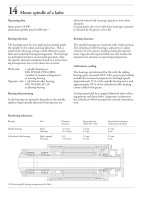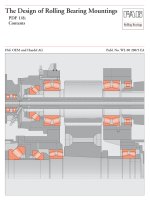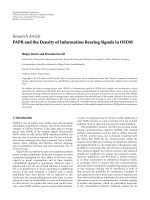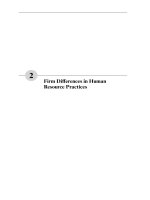The Design of Rolling Bearing Mountings Part 14 docx
Bạn đang xem bản rút gọn của tài liệu. Xem và tải ngay bản đầy đủ của tài liệu tại đây (917.57 KB, 15 trang )
120 Fresh air blower
Weight of impeller 0.5 kN, weight of shaft 0.2 kN,
thrust 0.3 kN; speed 3,000 min
–1
.
Bearing selection
Since a simple and economical mounting is required, a
plummer block FAG SNV120.G944AA with a self-
aligning ball bearing FAG 2311K.TV.C3 is arranged at
either side of the impeller. Self-aligning bearings are
necessary because of the difficulty in aligning two sep-
arately mounted housings so accurately that the bores
are exactly aligned.
The housing is suitable for grease replenishment (suffix
G944AA). A grease nipple is provided at the housing
cap and a grease escape bore at the opposite side of the
housing base.
As long as the impeller is satisfactorily balanced the in-
ner rings of the bearings are circumferentially loaded.
They are mounted on the shaft with adapter sleeves
FAG H2311. However, when the imbalance forces ex-
ceed the weight of impeller and shaft the circumferen-
tial load is transmitted to the outer ring.
Calculation of the rating fatigue life shows that the
bearings are more than adequately dimensioned.
The SNV housings are made of grey-cast iron. The
housing bodies are split to simplify mounting.
Machining tolerances
Shaft to h9, cylindricity tolerance IT6/2 (DIN ISO
1101); housing to H7.
Lubrication, sealing
The bearings are lubricated with FAG rolling bearing
grease Arcanol L71V.
The housing is sealed on each side by an FSV felt seal.
120: Rotor mounting of a fresh air blower
121 Optical telescope
Operating data
The telescope is approximately 7 m high, 8 m long and
weighs about 10 t, corresponding to 100 kN. The mir-
ror diameter is 1 m. Due to the extremely low speed of
rotation of the yoke axle (1 revolution in 24 hours), a
very low and uniform bearing friction is required.
Moreover, the yoke must be guided rigidly and with
absolute zero clearance. Deflection of the yoke axle
under the effect of the overhanging load must also be
taken into account.
Bearing selection
The locating bearing at the upper end of the yoke sup-
port is a high-precision double-row angular contact
ball bearing with split outer ring. Its dimensions are
600 x 730 x 98 mm. The gap width between the two
outer rings is such that, when adjusting the bearing
axially, a preload of 35 kN is obtained. The lower end
of the yoke axle is supported by a cylindrical roller
bearing FAG NU1044K.M1.P51 acting as the floating
bearing.
Bearing assembly
Despite the large diameter of the yoke axle, the deflec-
tion still existing would result in increased friction in
the preloaded angular contact ball bearing unless suit-
able countermeasures were taken. The problem was
solved by mounting the cylindrical roller bearing in
two outer shroud rings whose inside diameters are ec-
centric to the outside diameter. These shroud rings are
rotated in opposite directions during mounting (D)
until the shaft deflection at the angular contact ball
bearing location is equalized. The crowned inner ring
raceway of the cylindrical roller bearing allows for
slight misalignments and shaft deflections.
Lubrication, sealing
Grease lubrication (FAG rolling bearing grease Arcanol
L186V). The cylindrical roller bearing is fitted with a
gap-type seal with grease grooves, the angular contact
ball bearing is sealed by a labyrinth.
Machining tolerances
Bearing Seat Diameter Form tolerance Axial run-out tolerance of
tolerance (DIN ISO 1101) abutment shoulder
Shaft j5 IT2/2 IT2
Angular contact ball bearing
Housing J6 IT3/2 IT2
Shaft, tapered taper 1 : 12 IT2/2 IT2
Cylindrical roller bearing
Housing K6 IT3/2 IT2
Telescope mass
2,500 kg
Yoke mass
2,500 kg
Locating bearing
Floating bearing
121: Optical telescope
Floating bearing
Locating bearing
Bending moment
Shroud rings
122 –124 Radiotelescope
For radioastronomy highly sensitive radiotelescopes are
used for picking up radio waves from the universe.
The radiotelescope antenna is a huge reflector in the
form of a paraboloid. The reflector is slewable about
an axis parallel to the earth surface, the elevation axis.
The whole telescope slews about the vertical axis, the
azimuth axis.
Operating data
Total mass of the radiotelescope 3,000 tons (load
approximately 30,000 kN); reflector diameter 100 m,
reflector mass 1,600 tons (load approximately
16,000 kN); speed of track rollers n
max
= 8 min
–1
,
n
min
= 0.01 min
–1
; track diameter 64 m.
A Reflector
B Azimuth axis
C Elevation axis
D King pin bearing
E Travelling gear (track rollers)
F Data wheel
122 Elevation axis
The reflector is supported on two spherical roller bear-
ings FAG 241/850BK30.P62 (static load rating C
0
=
49,000 kN). Each of the two bearings has to accom-
modate a radial load of 8,000 kN. Added to this are
the loads resulting from the effects of wind and snow
on the reflector. Maximum loads in the horizontal di-
rection may be 5,500 kN, in the vertical direction
3,000 kN. Bearing centre distance is 50 m. The bear-
ings feature tolerance class P6 and radial clearance C2
(smaller than normal clearance CN). The bearings are
mounted onto the journals with tapered sleeves by
means of the hydraulic method. During mounting the
radial clearance is eliminated by driving in the sleeves.
Machining tolerances
Journal to h7 / housing to H6
Lubrication, sealing
The spherical roller bearings are lubricated with FAG
rolling bearing grease Arcanol L135V.
The bearings are sealed by a rubbing seal.
122: Elevation axis
123 Azimuth axis (track roller and king pin bearings)
The radiotelescope with its complete superstructure is
supported on a circular track of 64 m diameter. The
roller track assembly, comprising four groups of eight
rollers each, transmits the weight of approximately
30,000 kN.
Every second roller of a roller group is driven. Each
roller is supported on two spherical roller bearings
FAG 23060K.MB.C2. The bearings are mounted on
the journal with withdrawal sleeves FAG AH3060H.
In the most adverse case one bearing has to accommo-
date approximately 800 kN. With the static load rating
C
0
= 3,550 kN the bearings are safely dimensioned.
The outer rings of the bearings are mounted into the
housings with axial clearance so that a floating bearing
arrangement is obtained. Since low friction is required
the rollers to not incorporate wheel flanges. Thus it is
necessary to radially guide the superstructure on a king
pin bearing. The FAG cylindrical roller bearing pro-
vided for this purpose has the dimensions 1,580 x
2,000 x 250 mm. The cylindrical roller outside diame-
ters are slightly crowned in order to avoid edge stress-
ing. By mounting the bearing with a tapered sleeve the
radial clearance can be eliminated, thus providing ac-
curate radial guidance.
Machining tolerances
Track rollers: Housing to H7
King pin: Journal to h7/ housing to M7
Lubrication, sealing
The spherical roller bearings in the track rollers are
lubricated with FAG rolling bearing grease Arcanol
L135V. The cylindrical roller bearing for the king pin
features circulating oil lubrication.
Sealing by multiple labyrinths.
123a: Roller track assembly
123b: King pin bearing
124 Data wheel
The data wheel is supported on a clearance-free FAG
four-point bearing with the dimensions 1,300 x 1,500
x 80 mm.
Radial runout < 10 µm,
Axial runout < 25 µm.
Machining tolerances
The four-point bearing is fitted according to the actual
bearing dimensions.
Lubrication, sealing
The four-point bearing is fully immersed in oil.
Sealing by a multiple labyrinth.
124: Data wheel
The Design of Rolling Bearing Mountings
PDF 8/8:
Glossary
Rolling Bearings
FAG OEM und Handel AG Publ. No. WL 00 200/5 EA
The Design of
Rolling Bearing Mountings
Design Examples covering
Machines, Vehicles and Equipment
Publ. No. WL 00 200/5 EA
FAG OEM und Handel AG
A company of the FAG Kugelfischer Group
Postfach 1260 · D-97419 Schweinfurt
Telephone (0 97 21) 91-0 · Telefax (0 97 21) 91 34 35
Telex 67345-0 fag d
Preface
This publication presents design examples covering
various machines, vehicles and equipment having one
thing in common: rolling bearings.
For this reason the brief texts concentrate on the roll-
ing bearing aspects of the applications. The operation
of the machine allows conclusions to be drawn about
the operating conditions which dictate the bearing
type and design, the size and arrangement, fits, lubri-
cation and sealing.
Important rolling bearing engineering terms are print-
ed in italics. At the end of this publication they are
summarized and explained in a glossary of terms, some
supplemented by illustrations.
Contents
Example Title PDF
GLOSSARY . . . . . . . . . . . . . . . . . . . . . . 8/8
Glossary
Additives
Additives are oil-soluble substances added to mineral
oils or mineral oil products. By chemical or physical
action, they change or improve lubricant properties
(oxidation stability, EP properties, foaming, viscosity-
temperature behaviour, setting point, flow properties,
etc.). Additives are also an important factor in calculat-
ing the attainable life (cp. also Factor K).
Adjusted bearing arrangement/ Adjustment
An adjusted bearing arrangement consists of two sym-
metrically arranged angular contact bearings or thrust
bearings. During mounting, one bearing ring (for an O
arrangement, the inner ring; for an X arrangement, the
outer ring) is displaced on its seat until the bearing ar-
rangement has the appropriate axial clearance or the re-
quired preload. This means that the adjusted bearing
arrangement is particularly suitable for those cases
where a close axial guidance is required, for example,
for pinion bearing arrangements with spiral toothed
bevel gears.
Alignment
Self-aligning bearings are used to compensate for mis-
alignment and tilting.
Angular contact bearings
The term "angular contact bearing" is collectively used
for single-row bearings whose contact lines are inclined
to the radial plane. So, angular contact bearings are an-
gular contact ball bearings, tapered roller bearings and
spherical roller thrust bearings. Axially loaded deep
groove ball bearings also act in the same way as angular
contact bearings.
Arcanol (FAG rolling bearing greases)
FAG rolling bearing greases Arcanol are field-proven
lubricating greases. Their scopes of application were de-
termined by FAG by means of the latest test methods
under a large variety of operating conditions and with
rolling bearings of all types. The eight Arcanol greases
listed in the table on page 179 cover almost all de-
mands on the lubrication of rolling bearings.
Attainable life L
na
, L
hna
The FAG calculation method for determining the at-
tainable life (L
na
, L
hna
) is based on DIN ISO 281 (cp.
Modified life). It takes into account the influences of
the operating conditions on the rolling bearing life and
indicates the preconditions for reaching endurance
strength.
L
na
=a
1
· a
23
· L [10
6
revolutions]
and
L
hna
=a
1
· a
23
· L
h
[h]
a
1
factor a
1
for failure probability
(DIN ISO 281);
for a normal (10%) failure probability a
1
= 1.
a
23
factor a
23
(life adjustment factor)
L nominal rating life [10
6
revolutions]
L
h
nominal rating life [h]
If the quantities influencing the bearing life (e. g. load,
speed, temperature, cleanliness, type and condition of
lubricant) are variable, the attainable life (L
hna1
,
L
hna2
, ) under constant conditions has to be deter-
mined for every operating time q [%]. The attainable
life is calculated for the total operating time using the
formula
L
hna
=
100
q
1
+
q
2
+
q
3
L
hna1
L
hna2
L
hna3
Adjusted bearing arrangement
(O arrangement)
Adjusted bearing arrangement
(X arrangement)
Adjusted rating life calculation
The nominal life L or L
h
deviates more or less from the
really attainable life of rolling bearings.
Therefore, the adjusted rating life calculation takes
into account, in addition to the load, the failure prob-
ability (factor a
1
) and other significant operating con-
ditions (factor a
23
in the FAG procedure for calculating
the attainable life).
Cp. also Modified life in accordance with DIN ISO 281.
Glossary
Arcanol rolling bearing greases · Chemo-physical data · Directions for use
Arcanol Thickener Base oil Consistency Temperature Colour Main characteristics
Base oil viscosity NLGI- range Typical applications
at 40°C Class
mm
2
/s DIN 51818 °C RAL
L12V Polyurea ISO VG 2 –30 +160 2002 Special grease for high temperatures
Mineral oil 100 vermillion
Couplings, electric machines
(motors, generators)
L71V Lithium soap ISO VG 3 –30 +140 4008 Standard grease for bearings with O.D.s > 62 mm
Mineral oil 100 signal violet
Large electric motors,
wheel bearings for motor vehicles,
ventilators
L74V Special soap ISO VG 2 –40 +120 6018 Special grease for high speeds and low temperatures
Synthetic 22 yellow-green
oil Machine tools,
spindle bearings,
instruments
L78V Lithium soap ISO VG 2 –30 +130 1018 Standard grease for bearings with O.D.s ≤ 62 mm
Mineral oil 100 zinc yellow
Small electric motors,
agricultural and construction machinery,
household appliances
L79V Synthetic 390 2 –30 +270 1024 Special grease for extremely high temperatures and
Synthetic yellow ochre chemically aggressive environments
oil
Track rollers in bakery machines,
piston pins in compressors,
kiln trucks, chemical plants
(please observe safety data sheet)
L135V Lithium soap 85 2 –40 +150 2000 Special grease for high loads,
wit EP additives yellow orange high speeds, high temperatures
Mineral oil
Rolling mills, construction machinery,
motor vehicles, rail vehicles,
spinning and grinding spindles
L186V Lithium soap ISO VG 2 –20 +140 7005 Special grease for extremely high loads,
with EP additives 460 mouse-grey medium speeds, medium temperatures
Mineral oil
Heavily stressed mining machinery,
construction machinery,
machines with oscillating movements
L223V Lithium soap ISO VG 2 –10 +140 5005 Special grease for extremely high loads, low speeds
with EP additives 1000 signal blue
Mineral oil Heavily stressed mining machinery,
construction machinery,
particularly for impact loads and large bearings
Glossary
Axial clearance
The axial clearance of a bearing is the total possible ax-
ial displacement of one bearing ring measured without
load. There is a difference between the axial clearance
of the unmounted bearing and the axial operating clear-
ance existing when the bearing is mounted and run-
ning at operating temperature.
Base oil
is the oil contained in a lubricating grease. The amount
of oil varies with the type of thickener and the grease
application. The penetration number and the frictional
behaviour of the grease vary with the amount of base
oil and its viscosity.
Basic a
23II
value
The basic a
23II
value is the basis for determining factor
a
23
, used in attainable life calculation.
Bearing life
The life of dynamically stressed rolling bearings, as de-
fined by DIN ISO 281, is the operating time until fail-
ure due to material fatigue (fatigue life).
By means of the classical calculation method, a com-
parison calculation, the nominal rating life L or L
h
, is
determined; by means of the refined FAG calculation
process, the attainable life L
na
or L
hna
is determined (see
also factor a
23
).
Cage
The cage of a rolling bearing prevents the rolling ele-
ments from rubbing against each other. It keeps them
evenly spaced and guides them through unloaded sec-
tions of the bearing circumference.
The cage of a needle roller bearing also has to guide
the needle rollers parallel to the axis. In the case of sep-
arable bearings the cage retains the rolling element set,
thus facilitating bearing mounting. Rolling bearing
cages are classified into the categories pressed cages and
machined/moulded cages.
Circumferential load
If the ring under consideration rotates in relation to
the radial load, the entire circumference of the ring is,
during each revolution, subjected to the maximum
load. This ring is circumferentially loaded. Bearings
with circumferential load must be mounted with a
tight fit to avoid sliding (cp. Point load, Oscillating
load ).
Cleanliness factor s
The cleanliness factor s quantifies the effect of contam-
ination on the attainable life. The product of s and the
basic a
23II
factor is the factor a
23
.
Contamination factor V is required to determine s.
s = 1 always applies to normal cleanliness (V = 1).
With improved cleanliness (V = 0.5) and utmost
cleanliness (V = 0.3) a cleanliness factor s > 1 is ob-
tained from the right diagram (a) on page 181, based
on the stress index f
s*
and depending on the viscosity
ratio .
s = 1 applies to < 0.4.
With V = 2 (moderately contaminated lubricant) to
V = 3 (heavily contaminated lubricant), s < 1 is ob-
tained from diagram (b).
Combined load
This applies when a bearing is loaded both radially and
axially, and the resulting load acts, therefore, at the
load angle .
Depending on the type of load, the equivalent dynamic
load P or the equivalent static load P
0
is determined
with the radial component F
r
and the thrust compo-
nent F
a
of the combined load.
Circumferential
load on inner
ring
Circumferential
load on outer
ring
Weight
Imbalance
Imbalance
Weight
Rotating inner ring
Constant load direction
Rotating outer ring
Constant load direction
Stationary inner ring
Direction of load rotating
with outer ring
Stationary outer ring
Direction of load rotating
with inner ring
Glossary
Consistency
Measure of the resistance of a lubricating grease to
being deformed.
Consistency classification to NLGI, cp. Penetration.
Contact angle ␣
The contact angle ␣ is the angle formed by the contact
lines of the rolling elements and the radial plane of the
bearing. ␣
0
refers to the nominal contact angle, i.e. the
contact angle of the load-free bearing.
Under axial loads the contact angle of deep groove ball
bearings, angular contact ball bearings etc. increases.
Under a combined load it changes from one rolling ele-
ment to the next. These changing contact angles are
taken into account when calculating the pressure dis-
tribution within the bearing.
Ball bearings and roller bearings with symmetrical roll-
ing elements have identical contact angles at their inner
rings and outer rings. In roller bearings with asymmet-
rical rollers the contact angles at inner ring and outer
ring are not identical. The equilibrium of forces in
these bearings is maintained by a force component
which is directed towards the lip.
α
Contact line
The rolling elements transmit loads from one bearing
ring to the other in the direction of the contact lines.
Diagram for determining the cleanliness factor s
a Diagram for improved to utmost cleanliness
b Diagram for moderately contaminated lubricant and heavily contaminated lubricant
1
V = 1
2.5 3 4 5 6 7 8 9 10 12 14 16 20
23
5
10
15
20
30
κ=1
κ=0.7
κ=0.5
1
V = 0.5 V = 0.3
κ=0.6
κ=0.9
κ=0.8
κ=1.5
κ=2
κ=2.5
κ=3
κ=3.5
κ=4
0.1
0.2
0.3
0.7
0.5
V = 1
V = 2
V = 3
0.05
0.03
a
b
Cleanliness factor sStress index f
s*
Cleanliness factor s
A cleanliness factor s > 1 is attainable for full-
complement bearings only if wear in roller/roller
contact is eliminated by a high-viscosity lubricant
and utmost cleanliness (oil cleanliness according
to ISO 4406 at least 11/7).









